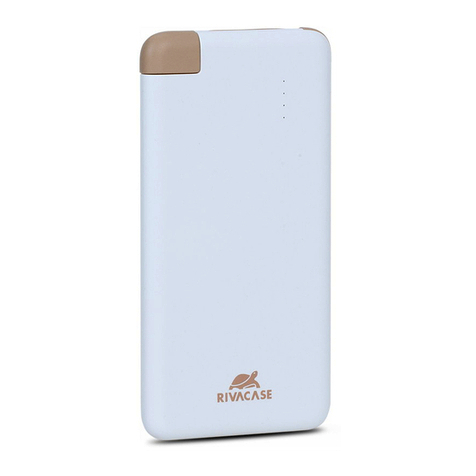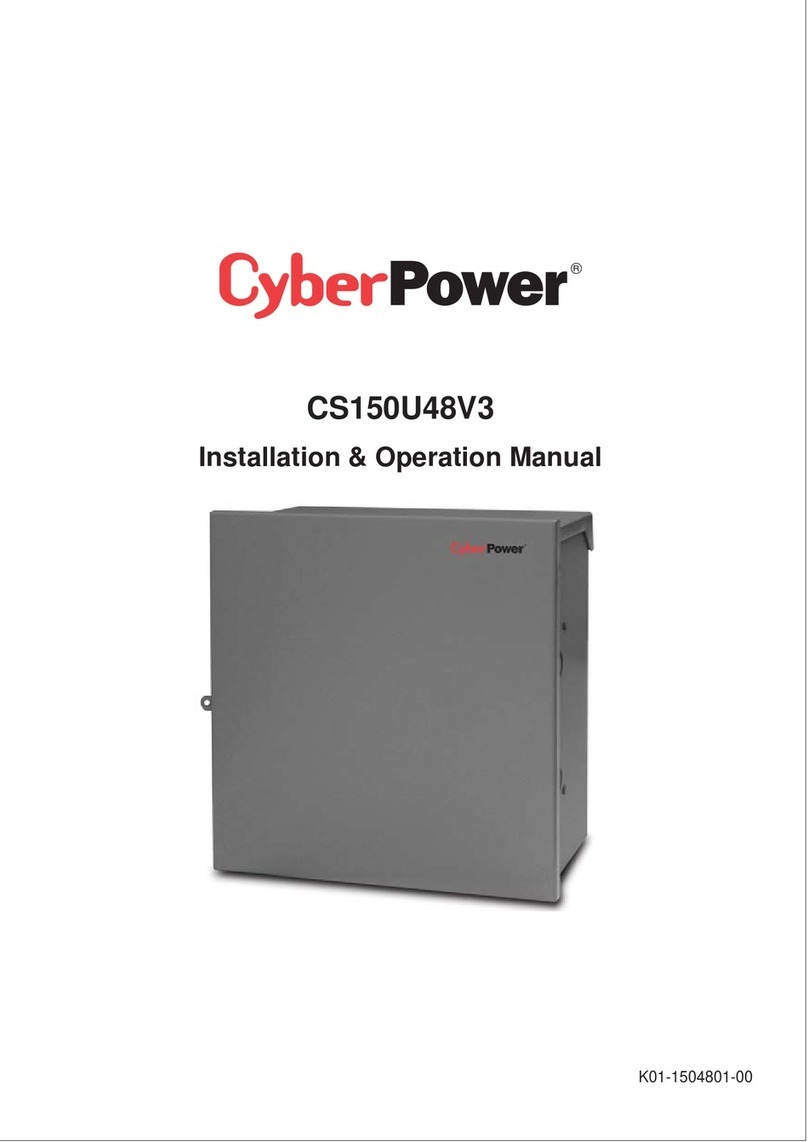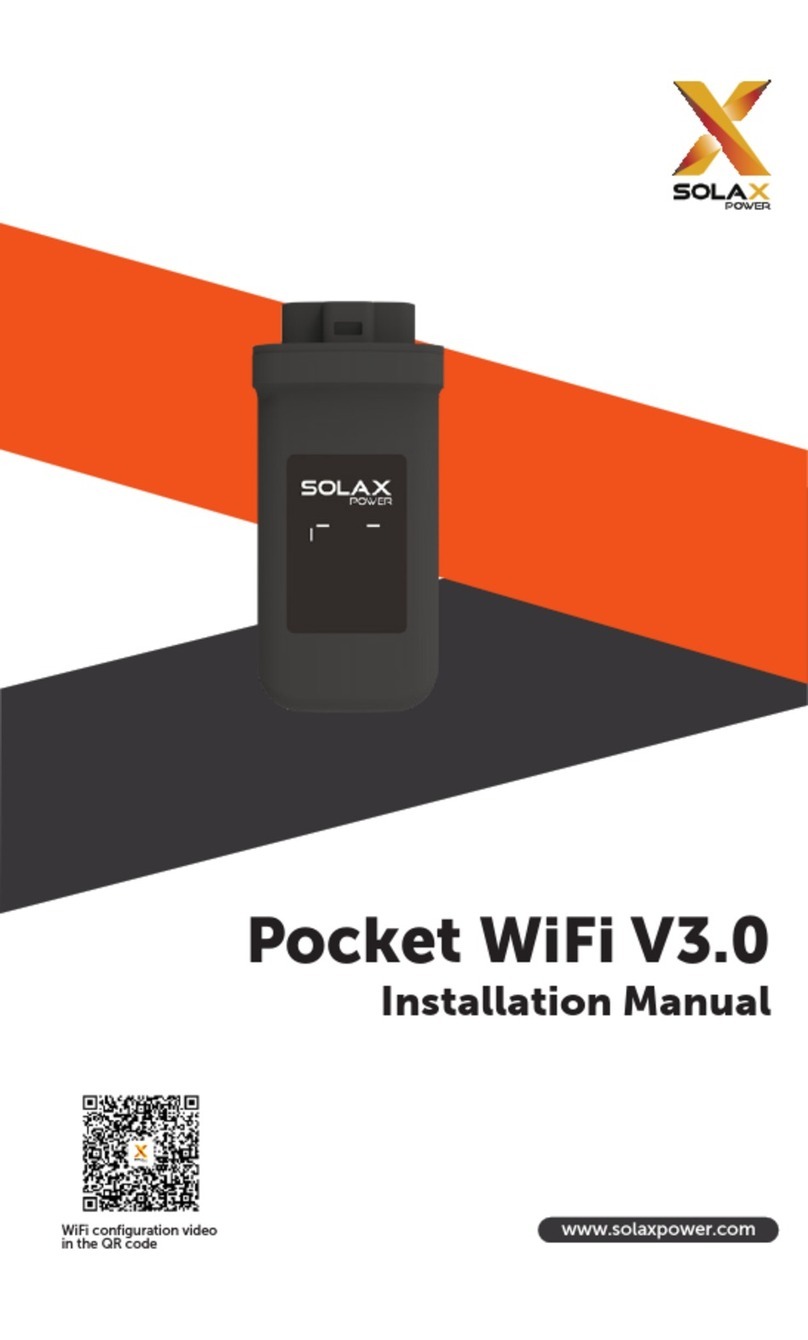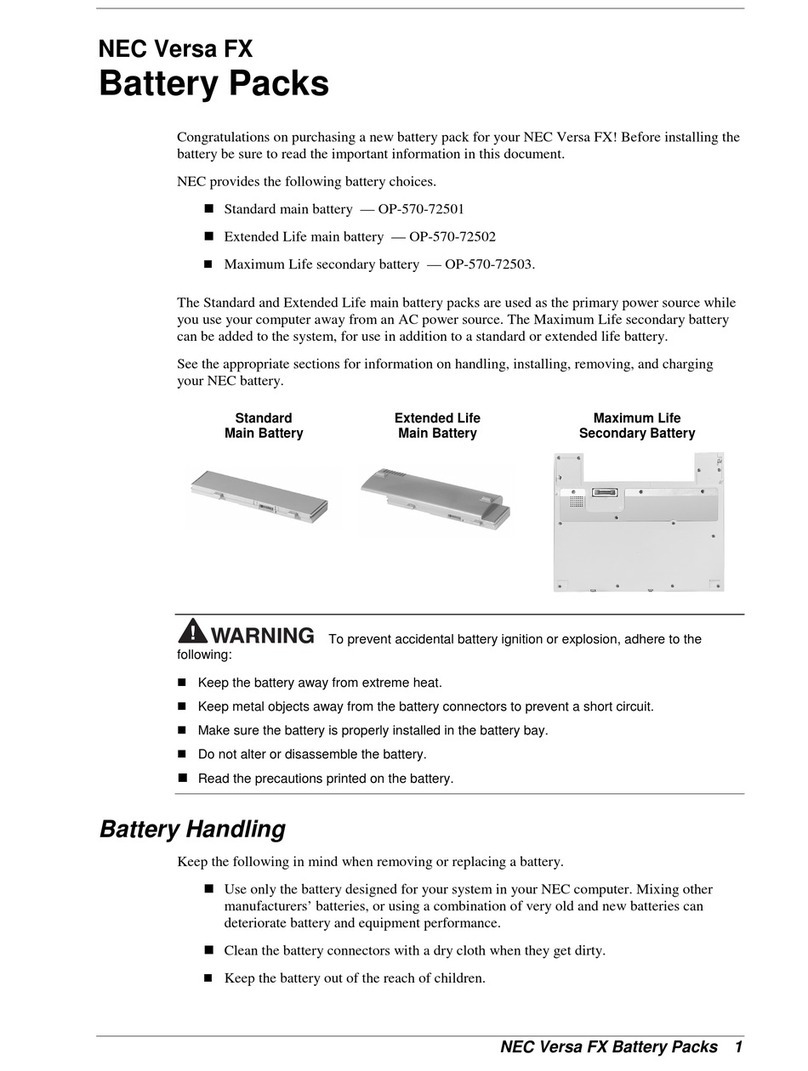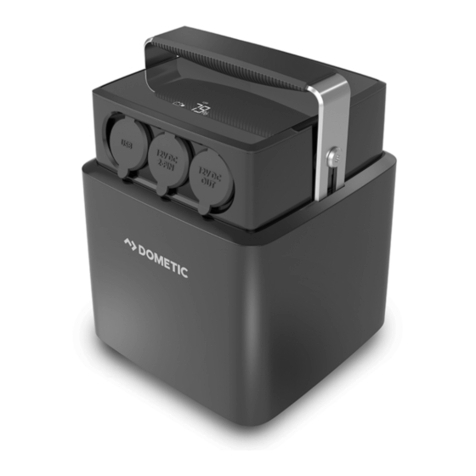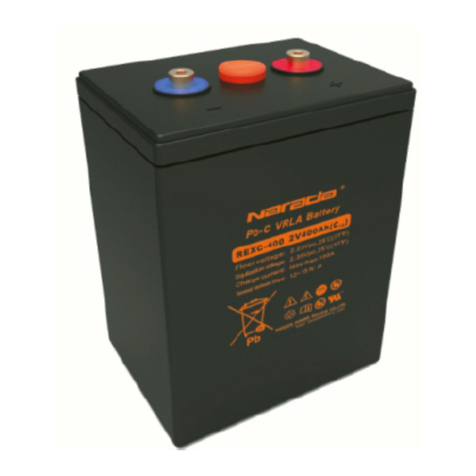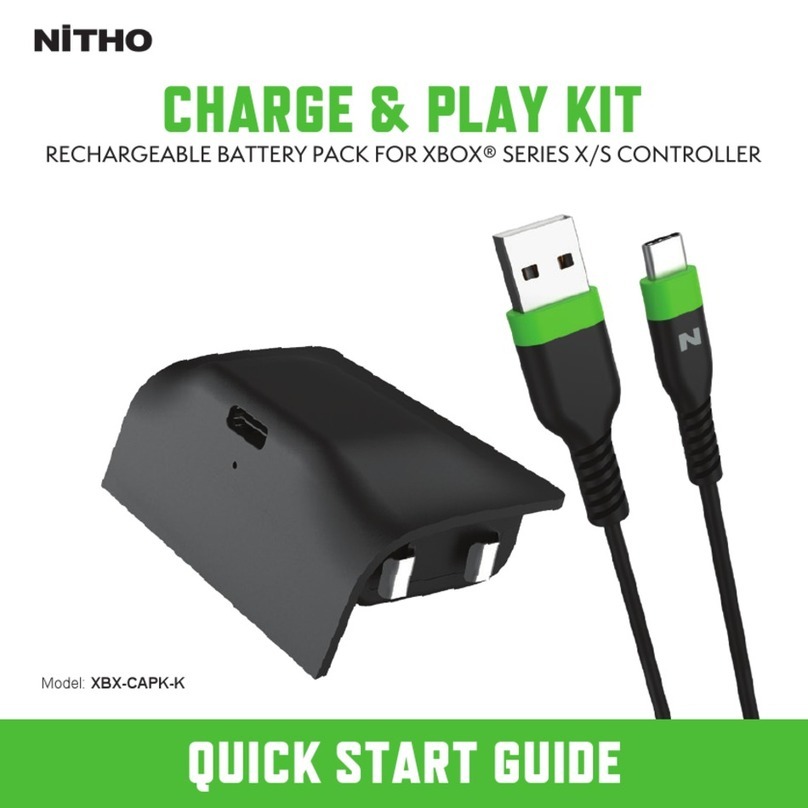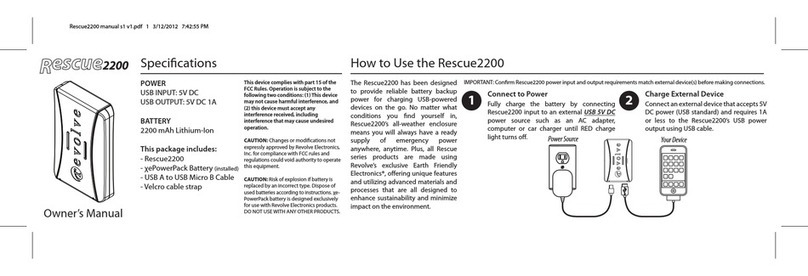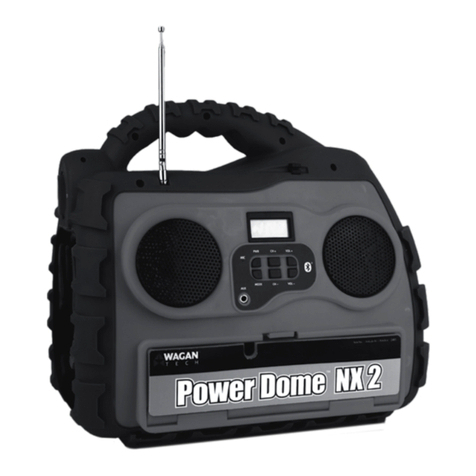Hawker FLEX ELITE User manual

OWNER’S MANUAL
www.hawkerpowersource.com
HAWKER FLEX®ELITE
TPPL BATTERY

CONTENTS
Introduction ...........................................3
Intended Use..........................................4
Battery Architecture..............................4
Operator Interfaces ...............................5
Safety......................................................7
Operational Data and Limits ................8
Handling .................................................9
Installation into Industrial Truck ..........9
Operation ...............................................10
Activation/Deactivation of Battery......10
Charging Battery ...................................11
Service and Maintenance .....................12
Troubleshooting ....................................12
Storage...................................................13
Description of Battery Labels...............14
Shipping HAWKER FLEX®Elite batteries
..14
Disposal and Recycling .........................15
Terms and Abbreviations......................15
2

The information contained in this document is critical
for safe handling and proper use of the HAWKER FLEX®
Elite battery for powering electrical industrial trucks. It
contains a global system specification as well as related safety
measures, codes of behavior, a guideline for commissioning and
recommended maintenance. This document must be retained and
available for users working with and responsible for the battery. All
users are responsible for ensuring that all applications of the system are
appropriate and safe, based on conditions anticipated or encountered during
operation.
This owner’s manual contains important safety instructions. Read and understand
the sections on safety and operation of the battery before operating the battery and
the equipment into which it is installed.
It is the owner’s responsibility to ensure the use of the documentation and any activities
related thereto, and to follow all legal requirements applicable to themselves and the
applications in the respective countries.
This owner’s manual is not intended to substitute for any training on handling
and operating the industrial truck or HAWKER FLEX®Elite battery that may
be required by local laws and/or industry standards. Proper instruction and
training of all users must be ensured prior to any contact with the battery
system.
Refer to the abbreviations and terms at the end of this document.
For service, contact your sales representative or call:
1-877-7HAWKER (USA and Canada)
www.hawkerpowersource.com
Your Safety and the Safety of others is Very Important
wWARNING You can be killed or seriously injured if
you don’t follow instructions.
INTRODUCTION
3

INTENDED USE
Intended Use
HAWKER FLEX®Elite batteries are designed for
industrial truck applications only. Only
HAWKER®-approved chargers are to be used with
HAWKER FLEX®Elite batteries.
The truck harness used between HAWKER FLEX®
Elite batteries and the industrial truck is dictated by
the truck original equipment manufacturer (OEM).
The truck harness shall comply with UL 583
requirements for electrical current carrying
capability and truck interface requirements.
Compliance shall be confirmed by the truck OEM.
wWARNING Installing the battery in a
non-UL 583 compliant truck is a fire risk due to a
potential for improperly sized cable harnesses, and
will void your warranty.
Battery Architecture
The parts of the battery are shown in Figures 1 & 2.
Figure 1: External Battery Features
Figure 2: Battery Management System (BMS)
Connections
Harness connection (35 pins) provides connectivity
to:
• Power
• Voltage sense leads (X2)
• Current measurement sensor
• CAN bus (charger communication)
• T°C (temperature leads [X3])
• Charger plug detection leads (X2)
• Contactor control
• Fan control leads (X2)
• HMI port allows connectivity with all the Human
Machine Interface devices as the BBWC and
HAWKER®battery discharge indicator (BDI)
• Controller area network (CAN) open port to
interface with the truck CAN bus
The battery is a modular design made of 12-Volt
Thin Plate Pure Lead (TPPL) blocs, combined
in serial and parallel to provide the energy
content required for the application. Different
configurations are available or can be designed.
Please contact your local HAWKER®representative
for more information.
The battery is protected by the BMS packaged
inside the unit. This control module contains
safety components and logic to control the main
contactor, preventing the operation of the battery
in unsafe or abusive conditions.
Figure 1
Cooling Fan
Primary
Charge Cable
Secondary
Charge Cable
(Connector type and appearance may vary.)
Figure 2
Truck Interface
Terminal
Operator
Interface Terminal
4

BATTERY ARCHITECTURE
Battery Architecture (cont.)
Safety Features:
• Functional safety qualified electronic monitoring
and control system to ensure safe electrical
operation within voltage, current and temperature
limits.
• A safe shut-off strategy to respond if operating
limits are violated (voltage, current, and
temperature).
• Charge circuit to prevent arcing if improper
disconnection is attempted.
• Dedicated handling/lifting points.
• Dedicated bloc ventilation to enhance
performance and energy throughput even in
high-temperature applications.
Interface Terminals: There are multiple low-voltage
interfaces on the battery exterior which must be
connected during commissioning, depending on
the end-user requirements:
Charge Interface Terminal: This is a required
connection for all HAWKER FLEX®Elite batteries.
This interface connects the charging adapter to
the battery system, allowing CAN communication
between the battery and charger.
Interface Terminals (cont.):
Truck Interface Terminal: This interface provides
specific communications for integration with the
truck’s state of charge (SoC) related features and
controls. This truck interface is not a requirement
from HAWKER®but may be required by the truck
manufacturer.
• Interlock: Allows the truck to send a signal to
tell the battery to shut down.
• Early Warning Signal: Battery will provide a
signal to the truck 10 seconds before battery
shutdown.
• CAN Open: Operating communications for
protocol sharing between truck and battery.
NOTE: If the use of this signal as the interface
with the truck is necessary, but not previously
discussed with HAWKER®, please contact your
HAWKER®service representative for support prior
to installation. Application prequalification and a
specialized cable could be required.
Operator Interface Terminal: 12-pin amphenol
connector to HAWKER® ABI device or battery
discharge indicator (BDI).
The low-voltage interfaces are protected by a 0.5A
fuse.
NOTE: Any unused connector must be protected
by a threaded cover to prevent the ingress of
contaminants or foreign material.
Operator Interfaces
An operator interface is required to be installed
in the truck cabin for ease of use and to ensure
the operator is alerted to any visual or audible
warnings such as low SoC. This in-cabin interface
can be either the BDI or the HAWKER® ABI smart
battery dashboard.
This requirement for an in-truck interface can only
be eliminated if full industrial truck OEM integration
options are deployed that allow the truck’s
preexisting operator interfaces to be utilized. Truck
integrations require prequalification and approval
from both HAWKER®and the truck OEM.
During operation as the SoC decreases, the
operator interfaces will provide an audible alarm
and visual warnings when the battery drops to the
Warning SoC level. After the battery continues to
fall below the alert level, the alarm will increase
in speed. Continuing to run the battery without
charging will ultimately result in the battery
deactivating due to low SoC.
The buzzer and LED behavior for the devices are as
follows:
• Warning SOC ON 1 sec./OFF 1 sec.
• Alert SOC ON 0.5 sec./OFF 0.5 sec.
• BMS error ON 0.1 sec./OFF 0.1 sec.
5

OPERATOR INTERFACES
Operator Interfaces (cont.)
With truck integration, the CAN cable must be
connected from the CAN port on the battery
(Figure 2 [see page 4]) to the truck. With truck
integration, warnings and alerts will follow the truck
OEM’s structure.
External BDI:
This device can be installed outside of the battery
compartment to allow operators to view the SoC
and the presence of a battery error as well as to
provide easy access to an activation/deactivation
button. The series of lights will indicate the SoC,
whilst audible alarms will notify the operator
that the battery requires recharging or that there
are battery errors. Continued operation after the
BDI indicated low SoC will ultimately result in
deactivation of the battery due to low SoC. The
BDI must be permanently and securely fixed in
a position for the operator to view the BDI for
information and access the button.
Figure 3: External BDI
Figure 4: SoC indicator screen
Truck iQ™ Smart Battery Dashboard:
Figures 5 & 6: HAWKER®ABI smart battery
dashboard
HAWKER®Advanced Battery Interface™ Dashboard:
The HAWKER®ABI smart battery dashboard is an
operator interface that provides operators with
more detailed battery information compared to
the BDI. The HAWKER®ABI device includes the
activation/deactivation button, as well as audible
and visual alarms. The HAWKER®ABI device
must be installed per the installation instructions
provided with the HAWKER®ABI device unit. The
HAWKER®ABI device must be permanently and
securely fixed in a position where the operator can
view the information and access the button.
Low SOC Audible Warnings
SOC Buzzer Stop Condition
Warning ON/OFF 1 sec. Normal SOC/On Charge
Alert ON/OFF 0.5 secs. Normal SOC/On Charge
Refer to the HAWKER®ABI smart battery device
manual for further information.
CAN bus Connectivity
The HAWKER FLEX®Elite battery can be integrated
into an OEM industrial truck CAN bus system which
allows full integration of the battery.
Figure 3
Figure 6
USoC 100% <75% <50% <25% Low Soc
or Error
Figure 4
Figure 5
6

SAFETY
Operator Interfaces (cont.)
Please contact your local HAWKER®Representative
for this option. This requires engineering
consultation between HAWKER®and the industrial
truck OEM.
HAWKER®MOD-ifi™ Smart Device App:
All data relating to the battery cycle life are stored
in the BMS (Figure 7).
The BMS data can be read wirelessly
through the HAWKER®MOD-ifi™
Smart Device App available
on both iOS®and Android™
platforms. Contact your HAWKER®
Representative for more information.
Safety
Important Safety Instructions
• Read all safety and operation instructions before
operating this battery.
• Anybody involved in handling, operating,
or maintenance of this battery must receive
appropriate training and use appropriately rated
tools and personal protective equipment.
• Follow all regulatory requirements for handling
electrical systems. The voltage of an electrical
system may impact what regulations are
applicable.
• Do not over-discharge or overcharge HAWKER
FLEX®Elite batteries as this poses a substantial risk
of damaging the battery.
• Only store and operate the battery within the
limitations given in the sections on operational
data and environmental limits.
• Keep the battery away from heat and ignition
sources.
• Do not charge or operate the battery in hazardous
environments.
• Only handle and store the battery in a dry
environment.
• Store only in monitored areas with suitable fire
control and protection per local requirements,
including local fire regulations.
• Recharge or operate only in monitored areas
with suitable fire control and protection per local
requirements, including local fire regulations.
• Recharge requires ventilation (refer to
local standards or contact your HAWKER®
Representative).
• Do not customize the battery hardware or software
as supplied by HAWKER®; or your warranty may
be voided.
• Only operate with HAWKER®-approved interface
devices.
• Service of the battery must only be performed by
HAWKER®-approved technicians.
• Dismantling of the battery is not authorized except
by qualified HAWKER®personnel due to potential
hazards involved; or your warranty may be voided.
• In the case of any error that cannot be reset,
do not attempt to continue the operation of the
battery until support and direction is provided by
HAWKER®; or your warranty may be voided.
• Do not leave the truck idle in temperatures below
the battery operating temperature as this may
result in the truck becoming nonoperational.
• Do not attempt to operate this battery in
temperatures above the operating range.
• Do not expose the battery to extended periods
of direct sunlight that allow the temperature of
the battery to rise above the storage or operating
temperatures of the battery.
• Do not operate the battery outdoors without
suitable weatherproof protection.
• Do not immerse the battery in water or clean the
battery using pressurized water.
• Do not operate the battery in condensing
environments.
• Do not install the battery on the underbody of an
electrical industrial truck.
Figure 7
7

SAFETY
Safety (cont.)
Interoperation with truck and battery charger
• The instructions in this owner’s manual do not
replace or supersede the instructions for the
truck and battery charger.
• The operation limits given in this owner’s manual
do not replace or supersede the permissible
operation parameters of the industrial truck or
charger.
• Only charge this battery with
HAWKER®-approved chargers for HAWKER
FLEX®Elite batteries.
• The battery must be installed in a truck with
appropriately sized cables.
Risks posed during normal operation
• This battery is designed to be stable and tolerant
to the applications within the scope laid out
in the operating conditions, however, battery
systems are inherently hazardous.
• Do not short the battery terminals. A shorting
event with a high current may occur, leading
to potential explosions and various hazards for
the operator. A resulting electric arc fault may
emit an intense hot flash of infrared, visible, and
ultraviolet light. Molten and vaporized metal
may be ejected. Toxic fumes may be released.
Components may become extremely hot.
• The weight and size of the battery make it
cumbersome to handle.
• Always properly restrain the battery. Failure to
restrain the battery may result in the battery
shifting or dropping. Additionally, this may result
in the battery crushing, pinching, or impacting
personnel or nearby equipment.
Damaged batteries
• Exposure of the battery to conditions outside of
its operational and environmental limits poses a
substantial risk of damage to the battery. Do not
assume damage to the battery will be apparent.
• If the battery experiences conditions outside of
the allowable limits as stated in this document,
immediately cease and do not resume operation,
and contact your HAWKER® Representative.
• If the mechanical integrity of the battery is
compromised (e.g., penetration of case, rupture
of the case, etc.) immediately cease and do not
resume operation of the battery. Contact your
HAWKER® Representative.
• Stop operation of the battery if there is a crush,
pinch, cut, or other damage to the power cables
or power connectors.
• If any material, such as liquid electrolyte, from
a damaged battery comes into contact with a
person’s skin or eyes, rinse the affected areas
with clean water for at least 15 minutes. Then
immediately obtain medical attention.
• If any material, such as liquid electrolyte, from
a damaged battery comes into contact with the
mouth or is swallowed, rinse out the mouth
as well as the area around the mouth. Then
immediately obtain medical attention.
• Contact with heated gases or components of
a damaged battery may cause serious thermal
burns. Treat any thermal burns, then immediately
obtain medical attention.
Additional information can be found in the safety
data sheet for the VRLA batteries, SDS 853027H.
Operational Data and Limits
• Nominal capacity: Nominal Capacity (C6) :
840 Ah
• Nominal voltage: 36V
• Configurations: 3 blocs series 3 blocs parallel
(3s3p)
• Max charging current: 588 Amps
• Discharge current (continuous): 1x C6, up to a
max of 320 A (limited by traction cable harness)
• Max energy throughput per day: up to 180% C6
8

HANDLING AND INSTALLATION
Handling
General Handling Considerations
• Handling of the battery is only allowed by trained
personnel that are familiar with the potential
risks of traction batteries for industrial trucks and
for lifting heavy loads.
• Avoid sudden acceleration, deceleration, drops,
and other mechanical abuse conditions while
handling the battery.
• Handling must only be performed after the
battery is disconnected from all electrical loads
and charge sources.
• Prior to lifting, secure all connectors and cables
so that they will not be crushed, pinched,
or otherwise damaged during the lift. User
interfaces may be removed prior to handling.
• Appropriate PPE must be worn during all lifts.
• Appropriate lifting methods and tools that can
safely lift and control the load must be checked
prior to all lifts. Tools must be properly rated for
weight.
• Attach lifting tools to the tray lifting points.
• The battery must only be lifted vertically. Do not
allow the battery to swing during lifting.
• The operational and safety instructions of the
lifting gear manual must be respected.
• If the battery is being handled while installed
on a truck, for instance during the battery
installation or removal operation, the truck must
be secured to prevent movement.
Installation into Industrial Truck
Mechanical Installation
• This battery is designed to be a direct
replacement of a standard lead-acid battery
intended to power an electric industrial truck.
• Upon receipt of the battery, it must be checked
for any visible signs of damage to the battery
and all cables, plugs, and accessories.
• Before installation, check that the battery is
supplied with the appropriate cable harness to
connect the battery to the industrial truck.
• Ensure that the battery weight and center of
gravity requirements per the truck manufacturer
are followed.
• The battery must be handled in a way that
mitigates the risk of drop events and crashes.
The correct tools, lifting points, and methods
should be used.
• After placement of the battery into the truck’s
battery compartment, the technician must ensure
the battery is mechanically secured in the truck
against movement as specified by the industrial
truck manufacturer. After the battery is secured
in the truck’s battery compartment, the battery
unit must be checked again to ensure no cables,
wires, or plugs were crushed, pinched, cut or
damaged during insertion.
Electrical Installation
• The battery must be connected with the
appropriate cables and connector to the
industrial truck per the truck manufacturer’s
recommendation.
• Only use HAWKER®-approved fasteners,
connectors, cabling, and plugs with this battery.
• The cable dimensioning and DC connecting plug
will vary depending on the truck and end-user
requirements. The truck harness shall comply
with relevant requirements for current carrying
capability and truck interface requirements.
Compliance shall be confirmed by the truck’s
OEM.
wWARNING Defective cables and connectors
can result in functional issues and/or severe safety
hazards such as short circuits and/or fire. Cables
and connectors must be regularly inspected for any
damage or issues. Cables and connectors should
only be repaired or replaced by an authorized
HAWKER® Representative using the correct factory
replacement parts. No substitution is allowed.
9

OPERATION
Operation
While HAWKER®has used reasonable efforts
towards the application of legal requirements, this
documentation should neither be considered nor
relied upon as legal advice.
Anybody using this battery must be trained on the
aspects of the battery they are responsible for as
required by local laws and regulations.
The battery must be handled, operated, stored,
maintained, and serviced in accordance with the
instructions in this owner’s manual.
wWARNING Failure to follow the instructions in
this owner’s manual can result in serious damage
to the battery and may result in serious injury.
Failure to follow the instructions in this owner’s
manual or using parts that are non-original will
void the battery warranty.
Opportunity charging is highly recommended
to maximize the daily operating capability of the
battery. It will also optimize the service life of the
battery by decreasing the discharge window of the
battery during discharge.
The capability of the battery to power the truck
decreases at low SOC. If the truck is operated at
a low SOC, this may result in the battery shutting
down with or without a 10-second warning. If this
occurs, reactivate the battery and slowly drive
the truck to a matching charger to connect and
recharge.
In contrast to traditional lead acid batteries, it is
beneficial to operate HAWKER FLEX®Elite batteries
at a partial state of charge with frequent and rapid
opportunity charges during periods of non-use
(operator breaks, shift changes, etc.).
This battery is designed to be charged indoors in
the truck.
The battery temperature influences the capacity of
the battery. For example, run time may be reduced
at lower temperatures. Battery temperatures at the
extreme ends of the temperature limits as stated in
this owner’s manual will influence performance.
Respect all visual and audible warnings from the
user interface devices.
Activation/Deactivation of Battery
The BMS will deactivate automatically when a
no-load condition is detected for a default setting
of 156 continuous hours to ensure that an unused
battery is not deeply discharged.
Activation:
During use: Provided the pack is not connected to a
charger and there are no battery errors, the battery
will automatically switch to the traction state
applying power to the truck. In all cases, a short
press of about half a second is required.
During charging: The battery is activated when it
is plugged into the charger. This allows battery
activation and charging even without previous
activation of the battery by other measures above.
Deactivation:
Extended non-use: The battery will deactivate after
a default of 156 hours when there is less than a
3 A current draw. If different values for these are
desired, contact your HAWKER® Representative to
make adjustments.
Manual deactivation: Ensure the equipment is shut
down prior to deactivating the battery. To manually
deactivate the battery, press the button on any user
interface for 3 to 5 seconds. Holding for longer
may result in turning the unit OFF and then back
ON.
wWARNING When deactivating the battery,
there is approximately a 20-second shutdown
sequence in which an audible alarm will be heard.
Pushing the button again during this time will stop
the shutdown procedure and return the pack to a
fully ON state.
10

CHARGING BATTERY
Charging Battery
Unlike standard lead acid batteries, HAWKER
FLEX®Elite batteries must remain connected to
the traction connector of the truck. To charge,
dedicated charging plug(s) must be used
connecting to a HAWKER®-approved charger. Upon
connecting the first charging plug, power to the
industrial truck is disabled, preventing inadvertent
operation.
This battery must only be charged by
HAWKER®-approved chargers for HAWKER FLEX®
Elite batteries, which are specially designed
to allow optimum energy transfer and CAN
communication with the battery to control the
battery recharge. This ensures a safe and optimal
operation of the system. All operating instructions
found in the owner’s manual of the charger must
be followed.
wWARNING Never attempt to charge using the
connector from the battery to the truck.
The battery system is equipped with drive-away
protection that will disconnect the traction power—
disabling the truck when any battery-charging plug
is connected to a charger. This mitigates the risk
of an operator accidentally driving away when the
charger is still connected.
Charge the battery only in an appropriate
environment. Additionally, follow all environmental
requirements from the charger.
The charge plug has embedded anti-arc contacts
to reduce arcing while performing inadvertent hot
disconnect operations.
NOTE: The CAN-enabled charge (piggy-back)
connector from the battery must be plugged into
the matching CAN-enabled charge connector from
the charger.
After installation is complete, the battery should
not be disconnected from the industrial truck to
charge, nor is it required to open the lids and
covers on the battery compartment.
Charging Sequence
• Inspect the battery and charging cable(s) to
ensure they have no damage and are free of
contaminants prior to connecting.
• Connect the charger to the battery-charging
connectors (both primary and secondary DC
cables).
• Once a charging cable is connected, the traction
contactor will open, removing power from the
truck for drive-away protection.
• Charging will begin after communication (CAN
bus) has started between the battery and
the charger, which occurs when the primary
charging cable with the communication links is
connected (Figure 8). The optimal charge current
will automatically be determined based on the
battery conditions (SOC, temperature, etc.) and
charger conditions (temperature, charger size).
The charge level will dynamically change during
the charging process, ensuring fast charging
and optimal lifetime of the battery. If the battery
detects a fault condition, the charging will stop.
• To stop prior to completion of full recharge, such
as during opportunity charging, press the ON/
OFF button on the charger prior to disconnecting.
wWARNING Even if the battery is equipped
with anti-spark systems, the battery should not
be disconnected while still being charged by the
charger.
• After a full charge cycle is complete, the charger
screen will indicate that charging is complete.
At this point, the charger is no longer supplying
power to the battery and the charging cable(s)
can be disconnected from the battery. After
completely disconnecting the charging cable(s),
the battery will then automatically be ready for
operation. If the battery remains connected, the
charger will periodically provide a refresh charge
to maintain the battery’s full state of charge.
Primary Cable
Top connectors: Charger
communication
Bottom connectors: Power
Secondary
Cable
(Power only)
(Connector type and appearance may vary.)
Figure 8
11

SERVICE AND TROUBLESHOOTING
Service and Maintenance
HAWKER FLEX®Elite batteries are designed to
be virtually maintenance-free. However, external
cabling, connectors, etc. (including operator
interfaces) must be regularly examined to ensure
there is no damage to such parts and in compliance
with local regulations. If any of these parts are
damaged or show signs of serious wear, they need
to be replaced. Please contact your HAWKER®
Representative for all repairs and replacements. All
repairs must be done by an authorized HAWKER®
technician trained on HAWKER FLEX®Elite products.
All power cables must be checked any time
the battery has been exposed to any type of
stress, whether it be overvoltage, overcurrent, or
mechanical stresses such as crushing.
Cleaning instructions
• The exterior of the battery can be cleaned using
warm water and an antistatic cloth.
• Do not clean the battery with pressurized water.
Troubleshooting
Battery does not provide power to the truck.
• Ensure the battery is turned on using an operator
interface.
• Deactivate and reactivate the battery.
• Ensure the battery is not connected to the
charger. Power to the truck is turned off during
charging to prevent drive-away from the charger.
• Confirm there are no active errors listed on the
user interface. In case of errors, review the error
ID checklist below.
• Inspect power cables to the truck to ensure they
are not damaged.
• If the battery has OEM integration, check the
communication cables between the truck and the
battery.
• Contact your HAWKER® Representative for
further troubleshooting steps.
Battery will not charge.
• Ensure the charger is powered and the charger
does not have any errors. In case of an error on
the charger, follow the instructions in the charger
owner’s manual.
• Deactivate and reactivate the battery.
• Ensure the charging cables are properly
connected to a HAWKER®-approved charger.
• Ensure the charger communication cable is
properly connected to the charge communication
port.
• Confirm there are no active errors listed on the
battery user interface. In case of errors, review
the error ID checklist below.
• Check connectors, auxiliary pins, and CAN cables
for damage.
• Contact your HAWKER® Representative for
further troubleshooting steps.
12

STORAGE
Storage
During storage, it is recommended to turn the
battery on at least every two months to confirm it
has not dropped below 75% SOC.
Make a full recharge cycle if the battery is below 75%
SOC.
The battery must be stored in a dry environment
away from fire, sparks, and heat.
The allowable storage temperatures are -40°F to
140°F (-40°C to 60°C). To ensure battery health and
maximize service life, the maximum temperature of
the long-term storage location should be less than
95°F (35°C).
The storage area must be compliant with local
regulations (including fire, safety, and building
regulations) for lead acid batteries and in accordance
with the building’s insurance.
The battery must only be stored in an upright
position (as installed in the vehicle) with all service
lids properly attached.
During storage, it is highly recommended to
disconnect the truck and battery communication
connector as there may be a slight trickle discharge.
When storing for longer than one month, precautions
must be taken to ensure the battery is not deeply
discharged. The pack must be stored at full charge.
Troubleshooting (cont.)
ID Description Action
8Contactor stuck open Contact your HAWKER®service representative
9Contactor stuck closed Contact your HAWKER®service representative
74 Interlock 1 or 2 error Contact your HAWKER®service representative
154 NTC Ambient (TP1) Contact your HAWKER®service representative
155 NTC Bloc 1 (TP2) Contact your HAWKER®service representative
156 NTC Bloc 3 (TP3) Contact your HAWKER®service representative
444 Fan error Contact your HAWKER®service representative for replacement
449 No charger CAN communication with
plug connected Contact your HAWKER®service representative
In case of any other error ID please contact your HAWKER® Representative for further troubleshooting direction.
Error ID Checklist and Recommended Actions
13

LABELING AND SHIPPING
Shipping HAWKER FLEX®Elite TPPL Batteries
HAWKER FLEX®Elite batteries are classified as
“non-spillable wet electric storage batteries” and
may be shipped by air or ground transportation
without restriction.
HAWKER FLEX®Elite batteries comply with the
requirements of:
1.US Dept of Transportation - 49 CFR Section
173.159 para d
2.ICAO/IATA Packing Instruction 872, Special
Provision A67
3.IMDG Class 8, UN ID 2800 special provisions
238
4.ADR 2011 and RID 2011 Special Provisions 238,
295, and 598 are classified as non-spillable
and exempt from hazardous goods regulations
when securely packed and protected against
short circuits.
For further transport and regulatory information
(USA and EU; classifications and labeling) refer
to VRLA batteries - SDS 853027H instructions or
regulations by the International Civil Aviation
Organization (ICAO), International Air Transport
Association (IATA), International Maritime
Dangerous Goods (IMDG), Convention concerning
the Carriage of Goods by Rail (CIM), and Annex A:
International Regulations concerning the Carriage
of Dangerous Goods by Rail (RID) codes. Other
laws and regulatory requirements may apply.
Description of Battery Labels
Label Type:
Identification Labels Danger Label
The danger label, located on the side of the battery,
contains warnings critical for safe usage of the
battery.
DANGER
CONTAINS: Lead, sulfuric acid (electrolyte), lead compounds, arsenic.
Harmful if swallowed, inhaled, or in contact with skin.
Acid causes severe skin burns and eye damage.
May damage fertility or the unborn child if ingested or inhaled.
May cause harm to breast-fed children.
May cause cancer if ingested or inhaled.
Causes damage to central nervous system, blood and kidneys through prolonged
or repeated exposure if ingested or inhaled.
Causes skin irritation, serious eye damage.
Irritating to eyes, respiratory system, and skin.
Contact with internal components may cause irritation or severe burns.
May form explosive air/gas mixture during charging.
Extremely flammable gas (hydrogen).
Explosive, fire, blast or projection hazard.
Obtain special instructions before use.
Do not handle unless all safety precautions have been read and understood.
Wash thoroughly after handling.
Do not eat, drink, or smoke when using he product.
Avoid contact during pregnancy/while nursing.
Wear protective gloves/protective clothing, eye protection/face protection.
Use only outdoors or in a well ventilated area.
Avoid contact with internal acid.
Do not breathe dust/fume/gas/mist/vapors/spray.
Keep away from heat/sparks/open flames/hot surfaces. No smoking.
IF SWALLOWED OR CONSUMED: Rinse mouth. Do NOT induce vomiting. Call a
poison center/doctor if you feel unwell.
IF ON CLOTHING OR SKIN (or hair): Remove/take off immediately all contaminated
clothing and wash it before reuse. Rinse skin with water/shower.
IN INHALED: Remove person to fresh air and keep comfortable for breathing.
Immediately call a POISON CENTER or doctor/physician.
IF IN EYES: Rinse cautiously with water for several minutes. Remove contact
lenses, if present and easy to do. Continue rinsing.
If exposed/concerned, or if you feel unwell seek medical attention/advice.
Store locked up in a well ventilated area, in accordance with local and national
regulations.
Dispose of contents/container in accordance with local and national regulations.
Keep out of reach of children.
WARNING: Cancer and reproductive harm. Wash hands after handling. www.
P65Warnings.ca.gov
WARNING: Risk of fire, explosion, or burns. Do not disassemble, heat above
60°C or incinerate. Not recommended for inverted use. Follow product charging
instructions.
EACH AND EVERY COMPONENT OF THIS BATTERY IS RECYCLABLE. VISIT OUR
WEBSITE FOR MORE INFORMATION CONCERNING RECYCLING.
HIGH VOLTAGE: RISK OF SHOCK. DO NOT TOUCH UNINSULATED TERMINALS OR
CONNECTORS.
Do Not Remove Vent Valves.
14

Disposal and Recycling
RECYCLING AND TERMS
Terms and Abbreviations
Term/Abbreviation Explanation/Description
BDI Battery Discharge Indicator
BMS Battery Management System
CCapacity at six-hour rate of discharge
DC Direct Current
LV Low Voltage (may also refer to communication)
OEM Original Equipment Manufacturer
PPE Personal Protective Equipment
SDS Safety Data Sheet
SOC State of Charge
SOH State of Health
Activated In an ON state
Deactivated In an OFF state
Cable Harness DC cable and plug that connects to the industrial truck or battery charger
Operation Refers to charging or discharging the battery. Includes idling of the battery
while activated
Storage Refers to the battery being stored
Handling Refers to activities such as lifting, moving, positioning of the battery. Includes
connecting and disconnecting of charge and power cables
Maintenance Cleaning of the battery and inspection of the battery and connected
components (charging cables and user interfaces) for damage
Service Operations performed by HAWKER® Representatives to restore the battery to
full performance
HAWKER FLEX®Elite TPPL batteries are recyclable.
Scrap units must be packaged and transported in
accordance with prevailing transportation rules
and regulations. Scrap units must be disposed of
in compliance with local and national laws by a
licensed or certified lead acid bloc recycler with
these attributes.
HAWKER®, in line with local regulations, will accept
HAWKER FLEX®Elite batteries and related products
at specific facilities for disposal. Contact your local
HAWKER® Representative for specific recycling
instructions for your area.
15

www.hawkerpowersource.com
© 2023 Hawker Powersource, Inc. All rights reserved. Unauthorized
distribution prohibited. Trademarks and logos are the property of Hawker
Powersource, Inc. and its affiliates .except UL, Android and iOS, which are not
the property of Hawker Powersource, Inc. Subject to revisions without prior
notice. E.&O.E.
AM-HFLE-OM REV. AA 0423
Table of contents
Popular Batteries Pack manuals by other brands

Odyssey
Odyssey PC310 user guide
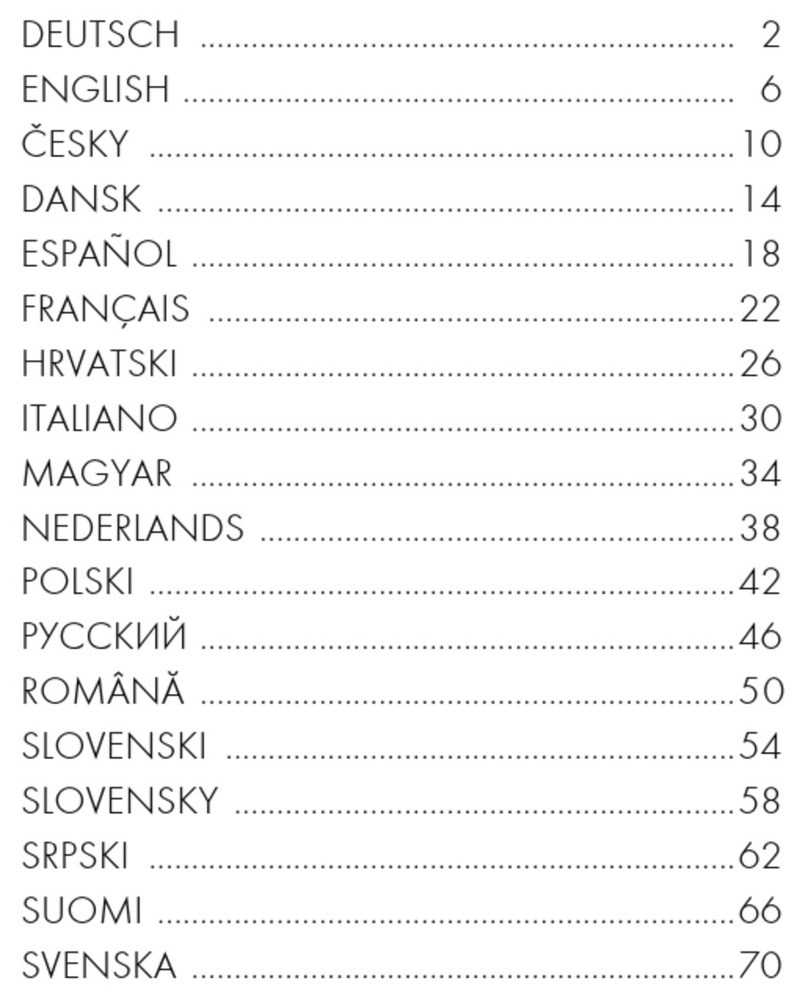
Swarovski Optik
Swarovski Optik RB AFL manual

EnerSys
EnerSys datasafe HX Installation, operation and maintenance instructions
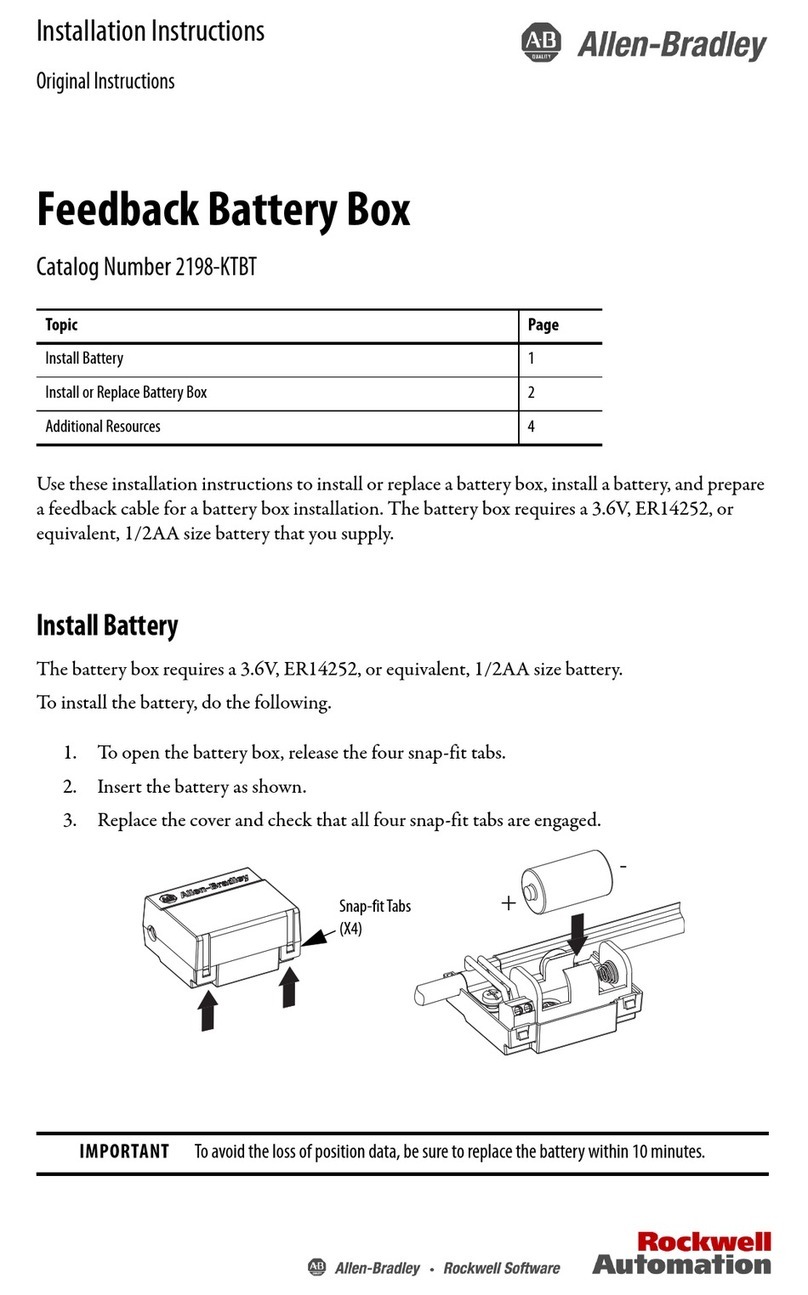
Rockwell Automation
Rockwell Automation Allen-Bradley 2198-KTBT installation instructions
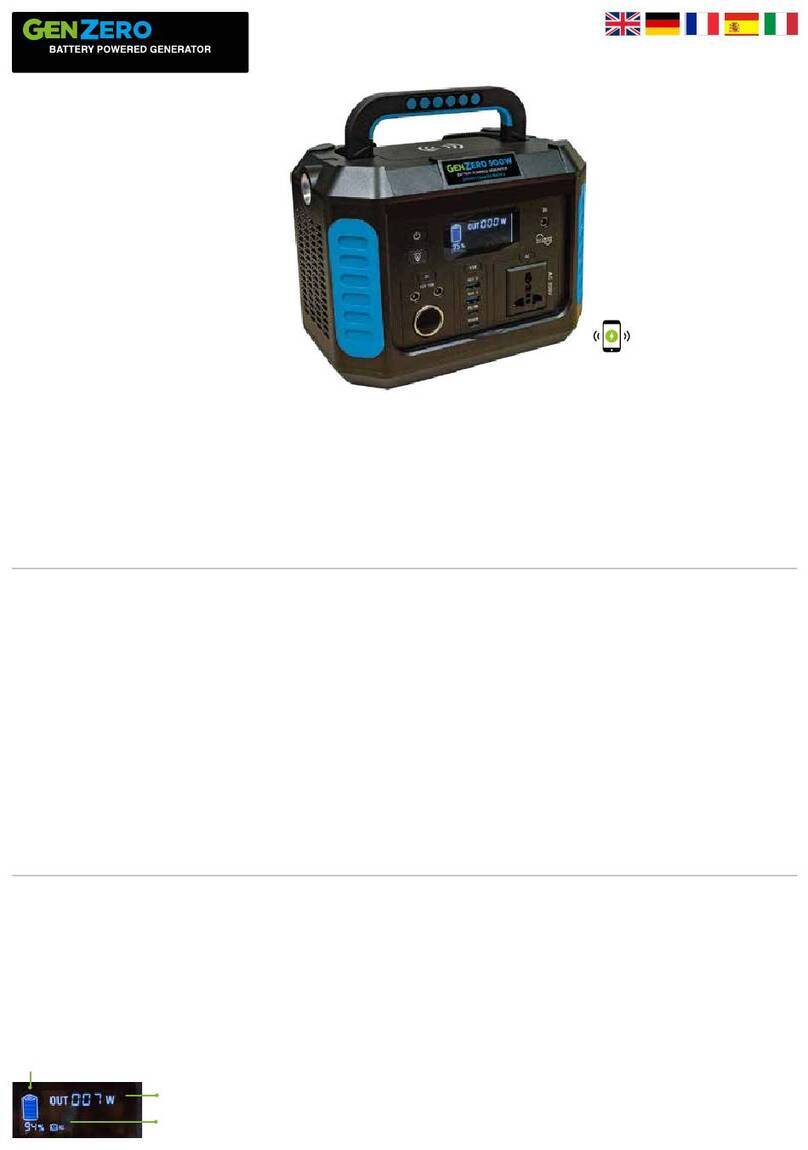
NightSearcher
NightSearcher GenZero 500W manual

Ozito
Ozito PXC PXUBP-460 instruction manual
